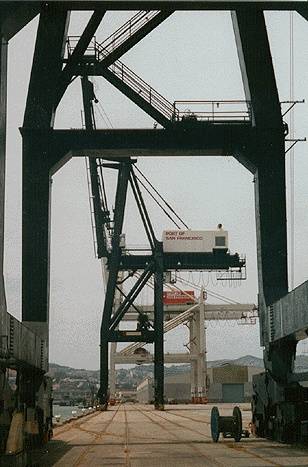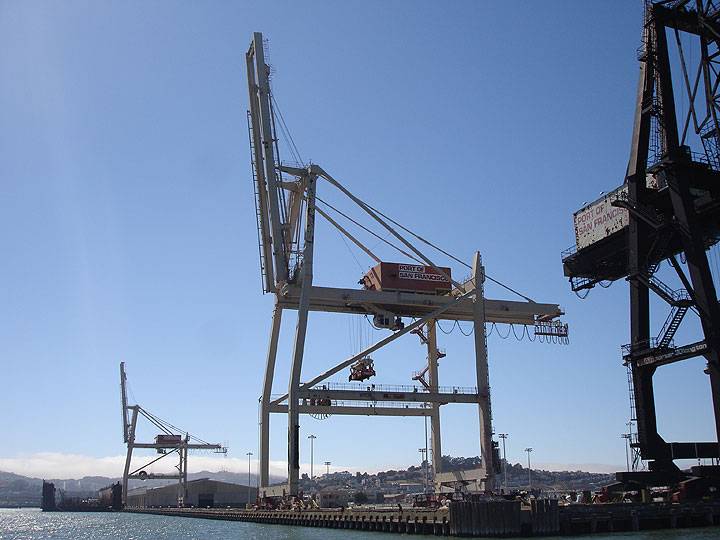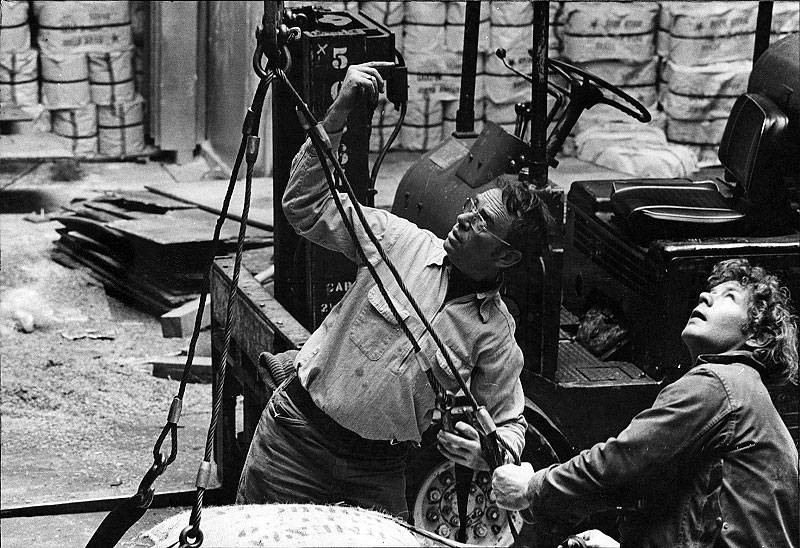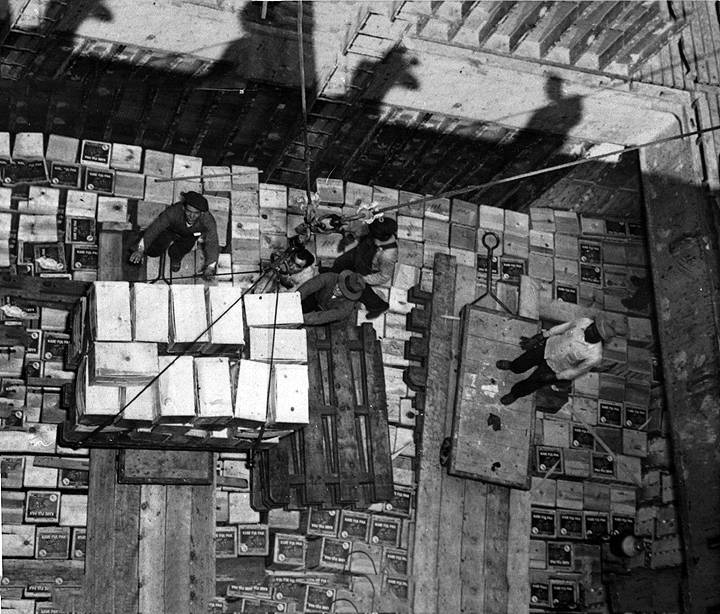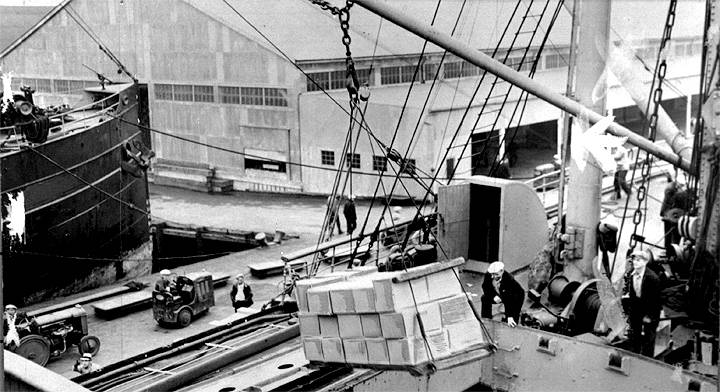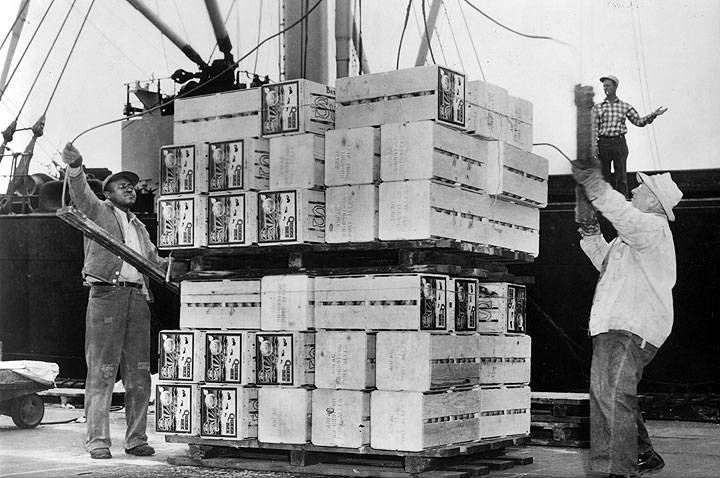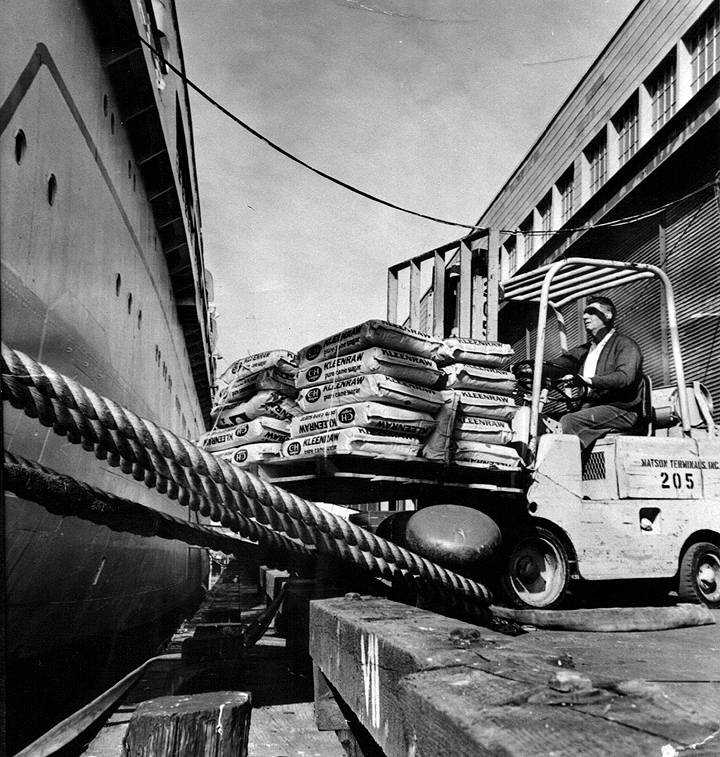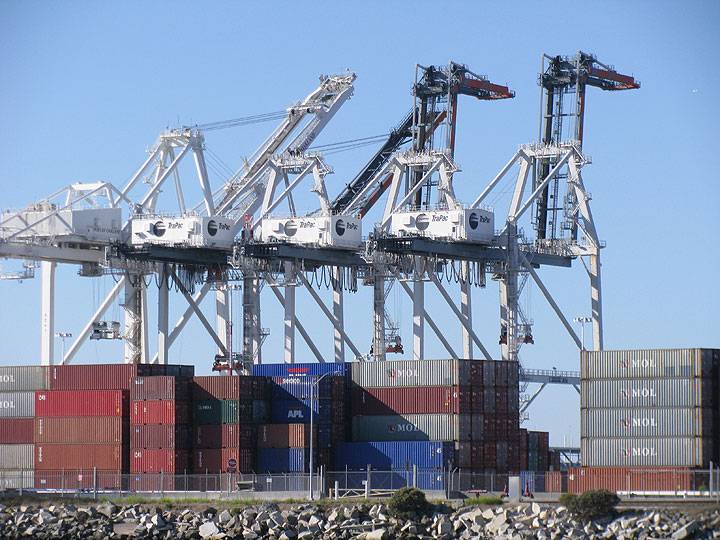Mechanization on the Waterfront
Historical Essay
by Chris Carlsson
Pier 80 along Islais Creek in 1997: site of the city's unused container facilities.
photo: Chris Carlsson
Pier 80, 2012.
Photo: Chris Carlsson
<iframe src="https://archive.org/embed/ssfHMCONTAN" width="640" height="480" frameborder="0" webkitallowfullscreen="true" mozallowfullscreen="true" allowfullscreen></iframe>
Herb Mills, former Secretary-Treasurer of Local 10, ILWU, speaks about the container
Interview by Chris Carlsson and Steve Stallone, 1996
Herb Mills and Peter Brown working in the hold of a ship, c. 1960.
Photo: Smithsonian
| In an effort to address the rise in mechanization in the 1950s, the International Longshoremen’s and Warehousemen’s Union (ILWU) entered into negotiation with the Pacific Maritime Association about a contract that would protect the economic and physical security of the workers, while new technology was implemented at the ports. This 1960 deal came to be known as the M&M Agreement (Mechanization & Modernization), and signified union submission to a technologically-designed speed-up of work, as well as a new stratification of the longshoring workforce. The agreement provided an impetus to change San Francisco from a maritime and manufacturing city to a white-collar metropolis, but at the cost of the industry that had founded it. |
San Francisco was primarily a maritime port during its first century as a city. The famous Barbary Coast of the 1800s and its associated saloons, boarding houses, and gambling parlors was the home to a shifting population of stevedores, sailors, merchant marines, etc. In 1921 a five-year push by the San Francisco Chamber of Commerce to break union power was finally consolidated when a longshore strike was violently suppressed and a company union (known as "The Blue Book") came to dominate the waterfront workers. The famous General Strike of 1934 led to a new wave of working class militancy. Three years later, west coast longshoremen left the International Longshore Association, based on the east coast, and created the International Longshoremen's and Warehousemen's Union (ILWU), cementing a foundation for a new era of worker strength in San Francisco.
Longshoremen unload the hold of a ship, 1950s.
Photo: San Francisco History Center, SF Public Library
While the government brought case after case against union president Harry Bridges from the 1930s to the 1950s, trying to nail him as a communist, to deport him, and so on, the workers in the ILWU firmly controlled the labor process along the waterfront and managed to establish some comfortable practices. The men had struck again and again to prevent slingloads from exceeding 2,100 lbs., and by the late '30s were under much less pressure to increase productivity. Eight-men crews were the norm, even though most situations didn't need more than two or four men at a time, so the work crews developed the 4-on, 4-off system, wherein at any given moment during the workday, four men would be sitting around drinking coffee and playing cards while the other four actually worked.
By the early 1950s the union itself had agreed to discourage such feather-bedding, but larger pressures were beginning to make themselves felt. Shippers were demanding lower costs from the shipowners and the unions. Shippers without sufficiently large loads were beginning to use intermediate freight stations, which soon established the methods of large-scale containerization, a technological change which drastically altered the relationship of living human labor to the quantity of goods being shipped.
Longshoring before the container on San Francisco's waterfront, utilizing pallets, cranes, winches.
Photo: San Francisco History Center, SF Public Library
Bridges and the other ILWU leaders began to openly discuss an about-face on mechanization, a process that had been resisted consistently until then. A union investigation into the situation in 1957 concluded "Presently it seems possible for the union to negotiate a contract embracing the full use of labor-saving machinery with maximum protection for the welfare of the workers." They sought a contract which would ensure no speed-up when a new machine was introduced; that machines would not create safety hazards; that dock-workers wouldn't be thrown out of the industry; that the workday would be cut while take-home pay stayed the same; that pensions and other benefits would be improved; and that if mechanization reduced the amount of available work, dockworkers would be guaranteed their weekly take-home pay nevertheless.
From 1958 to its conclusion in 1960, the ILWU and the Pacific Maritime Association negotiated intensively over the terms of what came to be known as the M&M Agreement (Mechanization & Modernization). Bridges and his colleagues had realized that they could only resist technological changes through guerrilla warfare for so long, and that ultimately it would lead to a showdown. Isolated from a larger labor movement, ignored or harassed by the government, and pressured by the rank-and-file to acquire health benefits, pensions, etc., the ILWU leaders concluded an historic agreement that saved shippers and the industry approximately $200 million during the 1960-66 contract period, and guaranteed longshoremen of that time wage increases, job security, increased benefits and pensions, and a large retirement bonus, equalling approximately $29 million in additional wealth for the workers.
In fact, under the M&M, longshoremen increased their wages, men over 62 were given early retirement bonuses of $7,920, and all medical, dental and pension benefits increased. But younger workers were sharply critical, with over a third voting against the deal. The writer Eric Hoffer, who was then a longshoreman, said "This generation has no right to give away, or sell for money, conditions that were handed on to us by a previous generation." A common complaint graffitied in piers and waterfront warehouses was that the speed-up was back with the M&M as slingloads increased dramatically -- Bridges Loads they were called.
One San Francisco longshoreman even got up in a 1963 union meeting and said:
"Brother Bridges has been saying for years that when the newspapers begin saying good things about him, it's time to get the recall machinery in motion. Brothers! That time has come!"
The speaker was censured by the local's executive board at the next meeting, and when that was in turn reported to the rank-and-file, they hooted down the board's move derisively.
Break bulk cargo hoisted to the dock.
Photo: San Francisco History Center, SF Public Library
Longshoreman moves sacks of sugar with forklift, c. 1960.
Photo: San Francisco History Center, SF Public Library
With the port doing a booming business throughout the early 60s, in large part due to the Vietnam War, the longshoremen found an accumulation of $13 million in their M&M fund by the 1966 end of the contract. After a few proposals were kicked around, the union voted to pay out $1,200 bonuses to all 10,000 full-time longshoremen on the Pacific Coast. A new agreement dumped the 35-hour week guarantee, but increased lump sum retirement bonuses to $13,000, increased wages and benefits. Meanwhile the Port of Oakland across the bay invested heavily in the new container cranes. Oakland also had the space to accommodate large storage areas and was conveniently served by direct rail and road lines from the Central Valley and all points north, south and east.
In 1971-72 the ILWU engaged in the longest strike in West Coast history, a strike whose issues are still debated today. But one of the main issues at the outset was the rise of "steady men" (via clause 9.43 in the collective bargaining agreement) to run the new container cranes. By the time the months-long strike was called off, the agreement was not much different than what was offered at the outset, with the union workers failing to stop the divisions among their own members.
By the mid-1970s, the San Francisco waterfront had been largely abandoned as too little, too slow, and too inefficient. A brief flurry of old-style longshoring accompanied the earliest days of consumer goods from China, but that, too, was soon supplanted by containerized shipping to Oakland to Long Beach and Los Angeles in southern California, and Seattle in the north.
In hindsight we can see that the M&M deal struck by the ILWU was the essence of an arrangement between capital and labor in the 20th century U.S. The union bargained away control over technological change in exchange for payment to the existing workforce and its retirees. Ultimately it agreed to become a much smaller labor aristocracy, although one could argue that the union had no choice under capitalist modernization.
This agreement was the turning point in San Francisco's economic history. After a hundred years of maritime, trading, and manufacturing in the city, San Francisco began its turn in becoming a headquarters city, a popular tourist destination, and a service sector capital. Regional planning, begun in earnest during WWII, led to new transportation grids and decentralization of blue collar industries. The ILWU's formal agreement to cooperate with a great technological leap in their work killed the San Francisco port and its jobs, and led to thousands fewer jobs in the large ports of today. It also signaled a willingness to submit by San Francisco's last bastion of serious labor resistance, the strikers of 1934. When the ILWU supported Joe Alioto for mayor in 1967, and went on to have leaders appointed to the Redevelopment Agency by Mayor Alioto, they completed their transition from acquiescing to enforcing the plans of the local and national elite.
Containers in Oakland, 2013.
Photo: Chris Carlsson
ILWU representative Wilbur Hamilton was appointed to the San Francisco Redevelopment Agency in 1968 and soon after got the job of project manager for the Western Addition A-2 project, the SFRA's largest neighborhood clearance plan. Hamilton gave a black , pro-labor face to the essentially white racist "slum clearance" plan devised in the boardrooms of downtown San Francisco.
Hamilton became the Executive Director of the SFRA in 1977. An ILWU organizer, Rick Sorro, was appointed to Mayor George Moscone's Select Committee on Yerba Buena Center in March, 1976. The ILWU, while less ardent than the SF Building Trades Council, the SF Central Labor Council, and the Teamsters Joint Council, had been supporting the South of Market redevelopment project called Yerba Buena Center, which was to include a new Convention Center. Ironically, this redevelopment plan came largely at the expense of retired longshoremen and other port workers who inhabited the old neighborhoods which were designated "blighted" in order to facilitate eminent domain clearance by the Redevelopment Agency. (See Western Addition Blues)

